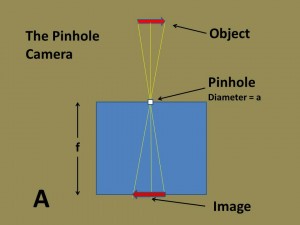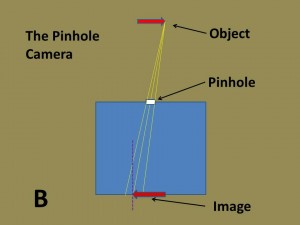
I’d like to begin to explore the technical aspects of photography today. A lot can be learned from what is ultimately the simplest of cameras, namely the pinhole camera. You can make a pinhole camera simply by taking a pin and punching a hole in the front of a cardboard box (see the accompanying figure A) and putting some sort of photosensitive material: film, paper, or imaging chip on the opposite side.
Suppose that we have some object that we wish to photograph. In physics books this is usually a candle, or a tree, or a minimalist arrow. Let’s go with an arrow. The thing is that every point on the arrow emits light rays in all directions. However, the pinhole only allows a single ray to enter the camera. This is true for every point of the arrow. As a result a perfect inverted image of the arrow forms on the camera’s image plane. The image plane, defined by the back of the box, is a distance f (for focal length) from the pinhole. Interestingly for a perfect pinhole camera f can be any value. Also, regardless of how far the object is from the pinhole the object is, a sharp image of it forms at the image plane. The camera has infinite depth of focus or field.
We typically define a parameter called the f-number of the camera that defines depth of focus. It is the focal length f divided by the diameter of the pinhole d.
f-number = focal length/aperture diameter
Here, a is zero; so f-number is infinite, as is the depth of field. Let’s consider what happens if the aperture becomes finite. This is illustrated is illustrated in figure b, where we consider some of the light rays coming from the tip of the arrow. More than one ray can now make it through the pinhole and as a result the image of the point is blurred out. The larger the aperture the more blurring occurs. Another point that you may recognize is that the various rays from the tip cross a vertical line centered where a perfect pinhole would form the image. As a result you can think of the image being blurred vertically as well. More importantly, if you think about it the closer the object is to the pinhole the more it becomes blurred. The finite aperture
 camera does its best job of image formation for an object at infinity and its worse for a point close to the aperture. Let me point out that lenses enable you to choose the distance for sharpest image, While for pinhole cameras this is always infinity. But it remains true that the smaller the f-number thr blurrier the image and the less “depth of focus” you have.
camera does its best job of image formation for an object at infinity and its worse for a point close to the aperture. Let me point out that lenses enable you to choose the distance for sharpest image, While for pinhole cameras this is always infinity. But it remains true that the smaller the f-number thr blurrier the image and the less “depth of focus” you have.
So with this simple pinhole camera we have illustrated:
- The concept of f-number,
- The inverse relationship between f-number and image sharpness,
- The relationship between depth of field and f-number.

Pingback: The dreaminess of pinhole photography | Hati and Skoll Gallery